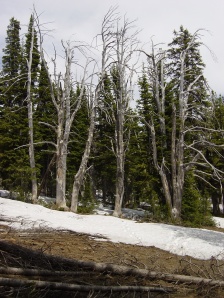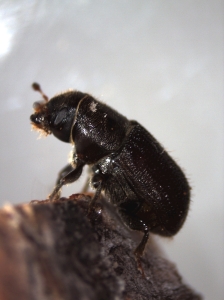It is possible that you have heard of the problem Montana’s forests have had lately with the mountain pine beetle. What you may not know is climate change is contributing to the massive scale of the recent outbreak. In this post we will show how climate change has affected the life cycle of this beetle and how one small species is impacting Montana’s landscapes by killing large numbers of trees across the state.
The mountain pine beetle is native to our forests and reproduces in all species of pines. It certainly has been in North American much longer than humans. These beetles live just under the surface of the tree bark, in the most nutritious part of the wood where sugars and other nutrients are transported, called the phloem. They lay their eggs, and their offspring burrow around in the phloem layer eating it up. The beetle larvae hatch from eggs, go through four larval stages, and eventually fly away to a new tree the following summer, and the circle of life starts again. So what has kept these timber hungry buggers from reducing our forests to sawdust? After all they have lived here long enough to eat all of our forests several times over.
Part of the answer lies in our bitter cold winters. Like all insects, which are cold-blooded, bark beetles’ development and reproduction are slowed, or halted by cold weather. Besides cold weather keeping rates of beetle reproduction (and thus overall numbers) in check, extreme cold can outright kill the beetles. So what does climate change have to do with this? You know how you might hear your grandpa say that winters were much harder when he was your age? Well…He’s right. When one hears about climate change in the news or in general conversations one usually hears about how hot it is going to get in the summer. That is a very important factor in climate change, however, what might be even more important is how climate change is going to raise the low temperatures throughout the year. Montana used to get a lot more harshly cold days and nights during the winter then we do now.
The bark beetle has grown accustomed to trying to survive extremely cold nights. In fact mountain pine beetles are able to pump their blood full of antifreeze so that when the bitterly cold nights of winter come, they are prepared for it! Even so, past winters used to be cold enough for a long enough amount of time that the beetles couldn’t hack it and died. So with every mild winter that comes, the beetles survival and reproduction rates go up. A few mild winters in a row lets the beetle population numbers grow almost unchecked. Lately Montana has been seeing a lot of relatively mild winters. This means an explosion in the beetle population into epidemic outbreak.
That alone might not be so bad as long as our trees could survive the beetle attacks. But here climate change has hit us with a double whammy. We have also seen drier years. With warmer years we have longer growing seasons, but the we aren’t getting enough precipitation to keep up with this longer growth period, so trees are continually stressed. Our trees require water to survive and grow, but they also need water for several other functions. Have you ever wondered what the purpose of tree sap is? I am sure there are lots of purposes for sap but one of its purposes is to expel foreign objects from its body by pushing out and drowning intruding beetles. Usually when beetles invades a tree, the tree tries, and often times succeeds in expelling the beetle from its trunk. However, a tree needs a lot of water to produce sap. With less water it can’t produce as much sap as it needs. Plus, as we explained earlier there are now more beetles than there ever have been in the past. So now our trees are trying to fight off more beetles than they ever have seen before with less sap then they are used to. Besides, when the beetle population numbers get to outbreak levels like they have recently been in areas like Helena, it doesn’t matter what kind of shape the trees are in, they haven’t got a chance!

Whitebark pine "ghosts", remnants of a mountain pine beetle outbreak that occurred in high elevation ecosystems during a warm period in the thirties. The death of the pines paved the way for sub-alpines firs to dominate the stand.
Climate change has raised the low temperatures in recent winters as your grandpa will argue. Plus, our forests are getting less water which makes them weaker and more susceptible to disease or infection. The combination of these two climate change effects have produced a huge population of bark beetles, and weak trees that have turned into the huge amount of dead trees in our forests throughout Montana.
Montana’s forests have been dying at an alarming rate. Especially hard hit are the high elevation whitebark pines. Living in a colder zone has spared many whitebark from previous mountain pine beetle outbreaks. This is not so anymore; high elevations are getting warmer so that in areas where the beetle used to require two years to complete development, it now only takes them one year. Ask your forester or logger friends about it. Imagine a decade from now what Montana will look like when many of our pines are dead from beetles and our forests are just starting the slow growth process back to the green forests that we are accustomed to seeing and rely on for the economy, recreational activities, and our lives. This is one example of how climate change is effecting us and Montana here and now!
